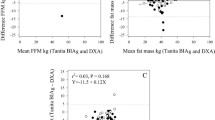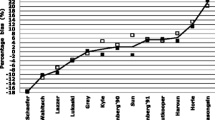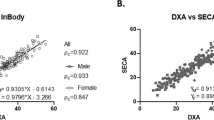Abstract
Objective
To validate body composition measurements by Bioelectric Impedance Analysis (BIA) against Dual-Energy X-ray Absorptiometry (DXA) as the reference method in healthy children and adolescents.
Design
Cross-sectional
Setting
Schools in and around Pune city, India.
Participants
A random sample of 210 (114 boys, 96 girls) apparently healthy Indian children and adolescents (5–18 y).
Methods
Weight, height, Tanner stage (TS) were recorded. Body composition measures: fat-free mass (FFM), fat mass (FM), lean mass (LM), bone mineral content (BMC) and body fat percentage (%BF) were assessed by BIA and DXA on a single day. Agreement between the methods was estimated by Pearson’s correlation, and Bland and Altman analysis.
Main outcome measures
%BF, FM, FFM, LM, BMC.
Results
BIA underestimated %BF by 6.7 (3.7)% as compared to DXA. Mean FFM, BMC and LM by BIA were significantly higher than by DXA (P<0.001). These differences remained similar after adjusting for age, BMI and TS. Mean differences between FFM (−2.32 (1.39) kg), BMC (−0.18 (0.15) kg), and LM (−2.15 (1.34) kg) by DXA and BIA were significant (P<0.01). Correlations between BIA and DXA were 0.92 for %BF, 0.96 for LM and 0.98 for FFM and BMC. Both the methods were similar in identifying normal and overfat children as per their respective cut-offs.
Conclusion
BIA and DXA techniques are not interchangeable for assessment of body composition. However, BIA may be used in the field/clinical setting preferably with ethnicity specific references.
Similar content being viewed by others
References
Khadilkar VV, Khadilkar AV, Cole TJ, Chiplonkar SA, Pandit D. Overweight and obesity prevalence and body mass index trends in Indian children. Int J Pediatr Obes. 2011;6:e216–24.
Deleuze Ntandou Bouzitou G, Fayomi B, Delisle H. Child malnutrition and maternal overweight in same households in poor urban areas of Benin. Sante. 2005;15:263–70.
Siervo M, Grey P, Nyan OA, Prentice AM. Urbanization and obesity in The Gambia: a country in the early stages of the demographic transition. Eur J Clin Nutr. 2006;60:455–63.
Jahagirdar R, Hemchand KP, Chiplonkar SA, Khadilkar VV, Khadilkar AV. Relationship between body mass index, fat distribution and cardiometabolic risk factors in Indian children and adolescents. Pediatr Obes. 2012;7: e37–41.
Artero EG, Ruiz JR, Ortega FB, España-Romero V, Vicente-Rodríguez G, Molnar D, et al. Muscular and cardio respiratory fitness are independently associated with metabolic risk in adolescents: the HELENA study. Pediatr Diabetes. 2011;12:704–12.
Steene-Johannessen J, Anderssen SA, Kolle E, Andersen LB. Low muscle fitness is associated with metabolic risk in youth. Med Sci Sports Exerc. 2009;41:1361–7.
Khadilkar AV, Sanwalka NJ, Chiplonkar SA, Khadilkar VV, Pandit D. Body fat reference percentiles on healthy affluent Indian children and adolescents to screen for adiposity. Int J Obes. 2013;37:947–53.
Barker DJ. The developmental origins of insulin resistance. Horm Res. 2005;64:2–7.
Helba M, Binkovitz LA. Pediatric body composition analysis with dual216 energy X-ray absorptiometry. Pediatr Radiol. 2009;39:647–56.
Sun G, French CR, Martin GR, Younghusband B, Green RC, Xie YG, et al. Comparison of multi-frequency bioelectrical impedance analysis with dual-energy X-ray absorptiometry for assessment of percentage body fat in a large, healthy population. Am J Clin Nutr. 2005;81:74–8.
Wang L, Hui SS, Wong SH. Validity of bioelectrical impedance measurement in predicting fat-free mass of Chinese children and adolescents. Med Scie Monitor. 2014;20:2298–310.
Li YC, Li CI, Lin WY, Liu CS, Hsu HS, Chen FN, et al. Percentage of body fat assessment using bioelectrical impedance analysis and dual-energy X-ray absorptiometry in a weight loss program for obese or overweight Chinese adults. PloS One. 2013;8:e58272.
Gutin B, Litaker M, Islam S, Manos T, Smith C, Treiber F. Body-composition measurement in 9-11–y-old children by dual-energy X-ray absorptiometry, skinfold-thickness measurements, and bio impedance analysis. Am J Clin Nutr. 1996;63:287–92.
Khadilkar V, Yadav S, Agrawal KK, Tamboli S, Banerjee H, Cherian A, et al. Revised Indian Academy of Pediatrics 2015 growth charts for height, weight and body mass index for 5 to 18-year-old Indian children. Indian Pediatr. 2015;52:47–55.
Khadilkar AV, Sanwalka NJ, Chiplonkar SA, Khadilkar VV, Mughal MZ. Normative data and percentile curves for dual energy X-ray absorptiometry in healthy Indian girls and boys aged 5-17 years. Bone. 2011;48:810–9
Bland JM, Altman DG. Measuring agreement in method comparison studies. Stat Methods Med Res. 1999;8:135.
McBride GB. A Proposal for Strength-of-Agreement Criteria for Lin’s Concordance Correlation Coefficient. NIWA Client Report: HAM2005-062; National Institute of Water & Atmospheric Research: Hamilton, New Zeeland, May 2005.
Khadilkar VV, Khadilkar AV, Borade AB, Chiplonkar SA. Body mass index cut-offs for screening for childhood overweight and obesity in Indian children. Indian Pediatr. 2012;49:29–34.
Hosking J, Metcalf BS, Jeffery AN, Voss LD, Wilkin TJ. Validation of foot-to foot bioelectrical impedance analysis with dual-energy X-ray absorptiometry in the assessment of body composition in young children: The Early Bird Cohort. Br J Nutr. 2006;96:1163–8.
Sen B, Mahalanabis D, Kurpad AV, Shaikh S, Bose K. Total body water and fat free mass: Evaluation of equations based on bioelectrical impedance analysis in infants and young children in India. Br J Nutr. 2010;104:256–64.
McCarthy HD, Cole TJ, Fry T, Jebb SA, Prentice AM. Body fat reference curves for children. Int J Obes. 2006;30:598–602.
Wang J, Thornton JC, Kolesnik S, Pierson RN Jr. Anthropometry in body composition. An overview. Ann N Y Acad Sci. 2000;904:317–26.
Deurenberg-Yap M, Schmidt G, van Staveren WA, Deurenberg P. The paradox of low body mass index and high body fat percentage among Chinese, Malays and Indians in Singapore. Int J Obes Relat Metab Disord. 2000;24:1011–7.
Author information
Authors and Affiliations
Corresponding author
Rights and permissions
About this article
Cite this article
Chiplonkar, S., Kajale, N., Ekbote, V. et al. Validation of Bioelectric Impedance Analysis against Dual-Energy X-ray Absorptiometry for assessment of body composition in Indian children aged 5 to 18 years. Indian Pediatr 54, 919–924 (2017). https://doi.org/10.1007/s13312-017-1182-3
Received:
Revised:
Accepted:
Published:
Issue Date:
DOI: https://doi.org/10.1007/s13312-017-1182-3




